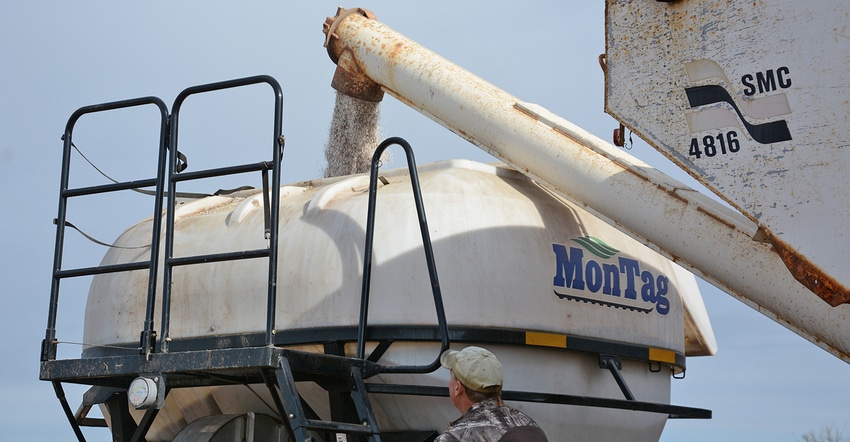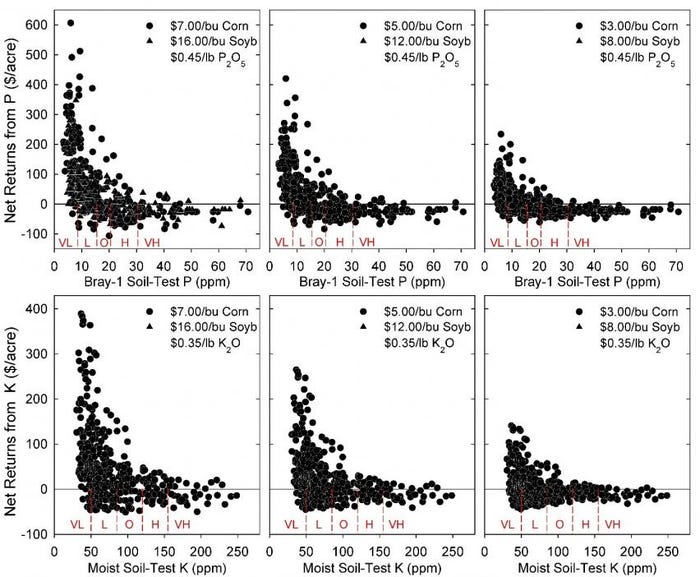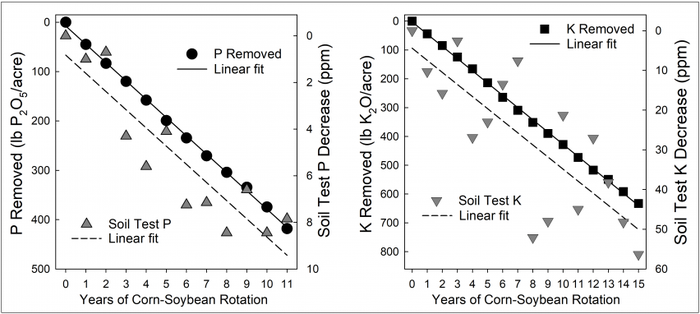October 3, 2019

By Antonio Mallarino, Professor of Soil Fertility and Nutrient Management, Extension Specialist
Very variable weather this season will result in variable corn and soybean yield within and between fields. Entire fields or portions of fields were planted later than usual or were not planted. This will result in variable removal of phosphorus (P) and potassium (K) with harvest. Reduced yields combined with continued low market values create uncertainty about P and K fertilization decisions for the 2020 season.
1. Management in fields with crops planted in 2019 and with grain or corn silage harvest
Soil testing and amounts of P and K removed with harvest are useful to decide P and K fertilization, especially with variable yields and low crop prices. Field research results from hundreds of trials were used to develop guidelines for P and K soil-test interpretations and fertilization rates (PM 1688, A General Guide for Crop Nutrient and Limestone Recommendations in Iowa). Soil testing is not a perfect diagnostic tool, but research has shown that crop yield increases from P and K fertilization are large and likely with test results in the Very Low and Low interpretation categories, small and less likely in the Optimum category, and very unlikely in the High and Very High categories. The suggested fertilizer rates for low-testing categories are based on yield response data, will result in maximum yield in most conditions and yield potentials, and will increase soil-test levels gradually depending on soil properties and actual yield levels. In soils testing Optimum, suggested application rates are based on nutrient removal with harvest (grain, silage, residue, hay, or pasture). To estimate removal, PM 1688 includes average P and K concentrations and indicates that producers or crop consultants should provide laboratories with site-specific information of the plant part harvested and prevailing yield level when submitting soil samples for analysis. Yield level included in the publication for removal-based rates use “default” yield levels (approximately state averages) because laboratories often do not receive yield information. Actual yields should be used to estimate P and K removal. No fertilization is suggested for the High and Very High testing categories other than starter with unseasonably cold and wet springs with thick crop residue cover.
Field research also has evaluated economic returns to investment in P and K fertilization of corn and soybean by using results from field trials. Figure 1 summarizes net returns from fertilization for different soil-test values and scenarios for three grain prices while maintaining the same fertilizer prices. In soils testing Very Low, economic benefit from fertilization are very high and very likely for all price scenarios. In low-testing soil benefits are lower but likely and most of the time well above break-even (zero return), even with lower grain prices than today. Therefore, producers are advised against reducing recommended P or K application rates for low-testing soils, because the benefits from investing in fertilization are large and likely even with current low prices. Application of removal-based rates to high-testing soils result in mostly negative returns for all price scenarios (losses to investment in fertilization), so producers should not apply removal-based rates at those test levels.

Net returns to P or K fertilization of corn and soybean for different soil-test levels in many Iowa soils for shown prices (interpretation categories Very Low to Very High are indicated).
In soils testing Optimum (for which removal-based rates are suggested) fertilization decisions are not as straightforward as for low-testing or high-testing soils. Figure 1 shows that benefits are much smaller but on average still above break-even for the highest price scenario for all yield levels (used prices of a few years ago). For the other price scenarios, however, returns bounce around break-even, with about equal probability of getting small benefits or small losses to investment in fertilization. Iowa producers typically apply P and K each year or a two-year rate for the corn-soybean rotation once before corn. With unsafe land tenure or seriously bad economic condition, producers who fertilize each year will increase profits with little chance of yield loss by reducing the removal-based rate, applying only starter, or even skipping P and K fertilizer application. Skipping a removal-based application will not maintain soil-test values, however, and in the future will have to apply a higher rate. Producers who fertilize every two years with application due for the 2020 crop year could do the same thing to increase profits from the first crop, but the cost of applying fertilizer again for 2021 might offset any gain unless prices are much better.
Another issue for maintenance of soils testing Optimum is that many producers are confused about the yield level that should be used to estimate P and K removal. The suggestion in publication PM 1688 is to use the “average or prevailing yield level” with the provided average P and K concentrations for different crops and harvesting systems. This suggestion means considering the yield levels during the last 3 or 4 years, not a yield goal, and not just this year’s yield even if it is lower or higher than normal. This is because, as Figure 2 shows, there is a good relationship between removal with harvest and P or K soil-test levels only over several years.

Relationship between cumulative P and K removed with grain harvest and soil-test change over time for plots not fertilized with P or K (Bray-1 for P and ammonium-acetate or Mehlich-3 tests for K).
2. Management in fields with prevented planting
The P and K management for 2020 in fields or portions of fields where corn or soybean could not be planted or drowned out in 2019 present additional challenges. If P and K could not be applied last fall or spring, producers can apply the same rates they were planning to apply and a new soil testing will not be essential for those fields or field areas. If P and K was applied, producers will not need to apply again for 2020 as long as volunteer weeds or seeded cover crops were not harvested for hay or silage and there was not severe erosion by rainfall or flooding. In Iowa soils, applied P and K from previous application (and no crop grown) will still be available for the 2020 crop.
If P and K was applied for the 2019 crop, and/or if biomass was removed or there was severe soil erosion, there is more uncertainty. In these cases, new soil sampling and testing may be the most rational and cost-effective solution. There is no reliable information about P and K removed by weeds or by several kinds of cover crops, and analysis of sampled biomass will provide quite variable and likely untrustworthy removal estimates. With severe soil erosion, much of the applied P and K may have been lost with surface soil runoff, especially in no-till fields. Other options are to apply a conservative rate, perhaps average annual crop removal from the previous 3 or 4 years, or use starter.
There has been much talk of “flooded soil syndrome” for fields or sections of fields where no crop was planted and there were no weeds or crop growth since the flood. In these cases soybean may require inoculation, and when P had not been applied, perhaps a higher P rate than planned or additional starter P may be justified for corn. Fact sheet “Flooded Soil Syndrome” provides further information
For additional information visit the Iowa State University Soil Fertility website.
Source: Iowa State University
The source is solely responsible for the information provided and is wholly owned by the source. Informa Business Media and all its subsidiaries are not responsible for any of the content contained in this information asset.
Read more about:
FertilizerYou May Also Like




